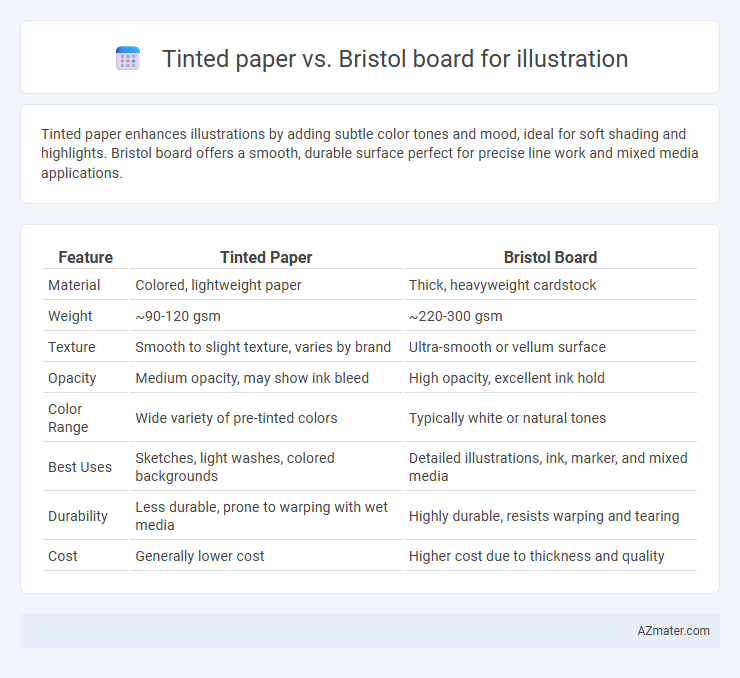Tinted paper enhances illustrations by adding subtle color tones and mood, ideal for soft shading and highlights. Bristol board offers a smooth, durable surface perfect for precise line work and mixed media applications.
Table of Comparison
| Feature | Tinted Paper | Bristol Board |
|---|---|---|
| Material | Colored, lightweight paper | Thick, heavyweight cardstock |
| Weight | ~90-120 gsm | ~220-300 gsm |
| Texture | Smooth to slight texture, varies by brand | Ultra-smooth or vellum surface |
| Opacity | Medium opacity, may show ink bleed | High opacity, excellent ink hold |
| Color Range | Wide variety of pre-tinted colors | Typically white or natural tones |
| Best Uses | Sketches, light washes, colored backgrounds | Detailed illustrations, ink, marker, and mixed media |
| Durability | Less durable, prone to warping with wet media | Highly durable, resists warping and tearing |
| Cost | Generally lower cost | Higher cost due to thickness and quality |
Introduction to Illustration Surfaces
Tinted paper offers illustrators a mid-tone background that enhances highlights and shadows, making it ideal for practicing light and contrast techniques. Bristol board provides a smooth, heavy-weight surface favored for its durability and versatility with various media such as ink, markers, and colored pencils. Choosing between tinted paper and Bristol board depends on the illustration style and desired visual effect, with tinted paper emphasizing tonal play and Bristol board supporting fine detail and bold line work.
What is Tinted Paper?
Tinted paper is a type of colored or toned paper used in illustration to provide a mid-tone background, enhancing contrast and depth when applying highlights and shadows. Unlike Bristol board, which is typically bright white and smooth for detailed line work, tinted paper adds a unique atmospheric effect, helping artists achieve a balanced composition with less reliance on heavy shading. Its textured or smooth surface options allow for varied media applications, making it ideal for mixed media, charcoal, and pastel illustrations.
What is Bristol Board?
Bristol board is a heavyweight, smooth, and durable paper favored by illustrators for its excellent surface texture that supports precise ink lines and vibrant color application. Unlike tinted paper, which offers a colored background that can influence the tone and mood of an illustration, Bristol board is typically white and provides a neutral base ideal for detailed work and mixed media. Its thickness reduces warping and bleed-through, making it a preferred choice for professional-quality illustrations requiring sharp detail and longevity.
Surface Texture: Tinted Paper vs Bristol Board
Tinted paper offers a smooth yet slightly toothy surface that enhances pencil and charcoal shading, allowing for softer transitions and subtle highlights in illustrations. Bristol board features a much smoother, hard surface ideal for precise ink work and fine detail, preventing bleeding and feathering of lines. The choice between tinted paper and Bristol board depends on the desired texture effect and medium control in illustration projects.
Color Interaction and Visual Effects
Tinted paper enhances illustration by providing a mid-tone base that allows colors to interact dynamically, making highlights and shadows more pronounced and vivid. Bristol board's smooth, bright white surface offers high color contrast and sharp detail, ideal for precise line work and vibrant pigment application. Choosing tinted paper results in softer, atmospheric visuals, while Bristol board delivers crisp, high-contrast effects emphasizing color saturation and clarity.
Compatibility with Drawing Media
Tinted paper offers excellent compatibility with dry media like charcoal, graphite, and colored pencils, as its textured surface grips pigment well and enhances mid-tone contrast. Bristol board is smoother and denser, making it ideal for ink, markers, and detailed pen work, providing clean lines and preventing bleed-through. Artists should match the paper to the drawing media to achieve optimal adherence, texture, and color vibrancy in illustrations.
Durability and Longevity
Tinted paper offers moderate durability and is primarily valued for its toned surface that enhances highlights in illustrations, but it is more susceptible to fading and damage over time compared to Bristol board. Bristol board, made from thick, multi-ply paper, is highly durable and resistant to warping, making it ideal for long-lasting illustrations that require repeated erasing or mixed media. For archival-quality artwork, Bristol board's longevity and ability to withstand handling and environmental changes significantly outperform tinted paper.
Cost and Availability
Tinted paper offers an affordable option for illustration projects, often available in various shades at lower prices compared to Bristol board. Bristol board tends to be more expensive due to its heavyweight, smooth surface preferred for detailed work, but it is widely available in art supply stores and online. Artists seeking budget-friendly materials with readily accessible options may favor tinted paper, while those prioritizing durability and texture often invest in Bristol board despite its higher cost.
Ideal Applications for Each Surface
Tinted paper is ideal for creating warm or moody illustrations where midtones are needed to enhance shading and highlights, making it perfect for charcoal, pastel, and colored pencil work. Bristol board offers a smooth, durable surface ideal for detailed ink drawings, marker art, and mixed media, providing excellent precision and color vibrancy. Artists often select tinted paper for expressive, textured effects, while Bristol board suits technical, clean-lined artwork requiring strong contrast and fine detail.
Choosing the Right Surface for Your Illustration Style
Tinted paper offers subtle color undertones that enhance pencil and pastel illustrations by providing a mid-tone background, ideal for artists seeking to create depth and mood with layering techniques. Bristol board, recognized for its smooth and rigid surface, excels in ink, marker, and detailed line work, supporting precision and vibrancy without bleed-through. Selecting the right surface depends on your preferred media and desired effects, with tinted paper favoring soft blending and tonal variance, while Bristol board suits crisp, graphic styles requiring durability and clean edges.

Infographic: Tinted paper vs Bristol board for Illustration
 azmater.com
azmater.com